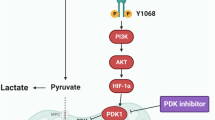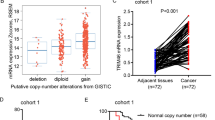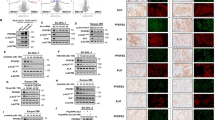Abstract
A high rate of aerobic glycolysis is a hallmark of malignant transformation. Accumulating evidence suggests that diverse regulatory mechanisms mediate this cancer-associated metabolic change seen in a wide spectrum of cancer. The echinoderm microtubule-associated protein-like 4-anaplastic lymphoma kinase (EML4-ALK) fusion protein is found in approximately 3–7% of non-small cell lung carcinomas (NSCLC). Molecular evidence and therapeutic effectiveness of FDA-approved ALK inhibitors indicated that EML4-ALK is a driving factor of lung tumorigenesis. A recent clinical study showed that NSCLC harboring EML4-ALK rearrangements displayed higher glucose metabolism compared with EML4-ALK-negative NSCLC. In the current work, we presented evidence that EML4-ALK is coupled to overexpression of hexokinase II (HK2), one of the rate-limiting enzymes of the glycolytic pathway. The link from EML4-ALK to HK2 upregulation is essential for a high rate of glycolysis and proliferation of EML4-ALK-rearranged NSCLC cells. We identified hypoxia-inducible factor 1α (HIF1α) as a key transcription factor to drive HK2 gene expression in normoxia in these cells. EML4-ALK induced hypoxia-independent but glucose-dependent accumulation of HIF1α protein via both transcriptional activation of HIF1α mRNA and the phosphatidylinositol 3 kinase-AKT pathway to enhance HIF1α protein synthesis. The EML4-ALK-mediated upregulation of HIF1α, HK2 and glycolytic metabolism was also highly active in vivo as demonstrated by fluorodeoxyglucose-positron emission tomography imaging of xenografts grown from EML4-ALK-positive NSCLC cells. Our data reveal a novel EML4-ALK-HIF1α-HK2 cascade to enhance glucose metabolism in EML4-ALK-positive NSCLC.
This is a preview of subscription content, access via your institution
Access options
Subscribe to this journal
Receive 50 print issues and online access
$259.00 per year
only $5.18 per issue
Buy this article
- Purchase on SpringerLink
- Instant access to full article PDF
Prices may be subject to local taxes which are calculated during checkout









Similar content being viewed by others
References
Warburg O . On the origin of cancer cells. Science 1956; 123: 309–314.
Vander Heiden MG, Cantley LC, Thompson CB . Understanding the Warburg effect: the metabolic requirements of cell proliferation. Science 2009; 324: 1029–1033.
Levine AJ, Puzio-Kuter AM . The control of the metabolic switch in cancers by oncogenes and tumor suppressor genes. Science 2010; 330: 1340–1344.
Dang CV . Links between metabolism and cancer. Genes Dev 2012; 26: 877–890.
Osthus RC, Shim H, Kim S, Li Q, Reddy R, Mukherjee M et al. Deregulation of glucose transporter 1 and glycolytic gene expression by c-Myc. J Biol Chem 2000; 275: 21797–21800.
Jones RG, Thompson CB . Tumor suppressors and cell metabolism: a recipe for cancer growth. Genes Dev 2009; 23: 537–548.
Rikova K, Guo A, Zeng Q, Possemato A, Yu J, Haack H et al. Global survey of phosphotyrosine signaling identifies oncogenic kinases in lung cancer. Cell 2007; 131: 1190–1203.
Soda M, Choi YL, Enomoto M, Takada S, Yamashita Y, Ishikawa S et al. Identification of the transforming EML4-ALK fusion gene in non-small-cell lung cancer. Nature 2007; 448: 561–566.
Shaw AT, Yeap BY, Mino-Kenudson M, Digumarthy SR, Costa DB, Heist RS et al. Clinical features and outcome of patients with non-small-cell lung cancer who harbor EML4-ALK. J Clin Oncol 2009; 27: 4247–4253.
Kwak EL, Bang YJ, Camidge DR, Shaw AT, Solomon B, Maki RG et al. Anaplastic lymphoma kinase inhibition in non-small-cell lung cancer. N Engl J Med 2010; 363: 1693–1703.
Shaw AT, Kim DW, Mehra R, Tan DS, Felip E, Chow LQ et al. Ceritinib in ALK-rearranged non-small-cell lung cancer. N Engl J Med 2014; 370: 1189–1197.
Koivunen JP, Mermel C, Zejnullahu K, Murphy C, Lifshits E, Holmes AJ et al. EML4-ALK fusion gene and efficacy of an ALK kinase inhibitor in lung cancer. Clin Cancer Res 2008; 14: 4275–4283.
Yoshida A, Tsuta K, Nakamura H, Kohno T, Takahashi F, Asamura H et al. Comprehensive histologic analysis of ALK-rearranged lung carcinomas. Am J Surg Pathol 2011; 35: 1226–1234.
Nishino M, Klepeis VE, Yeap BY, Bergethon K, Morales-Oyarvide V, Dias-Santagata D et al. Histologic and cytomorphologic features of ALK-rearranged lung adenocarcinomas. Mod Pathol 2012; 25: 1462–1472.
Choi H, Paeng JC, Kim DW, Lee JK, Park CM, Kang KW et al. Metabolic and metastatic characteristics of ALK-rearranged lung adenocarcinoma on FDG PET/CT. Lung Cancer 2013; 79: 242–247.
McDonnell SR, Hwang SR, Rolland D, Murga-Zamalloa C, Basrur V, Conlon KP et al. Integrated phosphoproteomic and metabolomic profiling reveals NPM-ALK-mediated phosphorylation of PKM2 and metabolic reprogramming in anaplastic large cell lymphoma. Blood 2013; 122: 958–968.
Choi YL, Takeuchi K, Soda M, Inamura K, Togashi Y, Hatano S et al. Identification of novel isoforms of the EML4-ALK transforming gene in non-small cell lung cancer. Cancer Res 2008; 68: 4971–4976.
Sasaki T, Rodig SJ, Chirieac LR, Janne PA . The biology and treatment of EML4-ALK non-small cell lung cancer. Eur J Cancer 2010; 46: 1773–1780.
Friboulet L, Li N, Katayama R, Lee CC, Gainor JF, Crystal AS et al. The ALK inhibitor ceritinib overcomes crizotinib resistance in non-small cell lung cancer. Cancer Discov 2014; 4: 662–673.
Hallberg B, Palmer RH . Mechanistic insight into ALK receptor tyrosine kinase in human cancer biology. Nat Rev Cancer 2013; 13: 685–700.
Dang CV, Semenza GL . Oncogenic alterations of metabolism. Trends Biochem Sci 1999; 24: 68–72.
Younes M, Brown RW, Stephenson M, Gondo M, Cagle PT . Overexpression of Glut1 and Glut3 in stage I nonsmall cell lung carcinoma is associated with poor survival. Cancer 1997; 80: 1046–1051.
Schonherr C, Ruuth K, Eriksson T, Yamazaki Y, Ottmann C, Combaret V et al. The neuroblastoma ALK(I1250T) mutation is a kinase-dead RTK in vitro and in vivo. Transl Oncol 2011; 4: 258–265.
Kuo AH, Stoica GE, Riegel AT, Wellstein A . Recruitment of insulin receptor substrate-1 and activation of NF-kappaB essential for midkine growth signaling through anaplastic lymphoma kinase. Oncogene 2007; 26: 859–869.
Messeguer X, Escudero R, Farre D, Nunez O, Martinez J, Alba MM . PROMO: detection of known transcription regulatory elements using species-tailored searches. Bioinformatics 2002; 18: 333–334.
Riddle SR, Ahmad A, Ahmad S, Deeb SS, Malkki M, Schneider BK et al. Hypoxia induces hexokinase II gene expression in human lung cell line A549. Am J Physiol Lung Cell Mol Physiol 2000; 278: L407–L416.
Semenza GL, Jiang BH, Leung SW, Passantino R, Concordet JP, Maire P et al. Hypoxia response elements in the aldolase A, enolase 1, and lactate dehydrogenase A gene promoters contain essential binding sites for hypoxia-inducible factor 1. J Biol Chem 1996; 271: 32529–32537.
Hubbi ME, Hu H, Kshitiz, Ahmed I, Levchenko A, Semenza GL . Chaperone-mediated autophagy targets hypoxia-inducible factor-1alpha (HIF-1alpha) for lysosomal degradation. J Biol Chem 2013; 288: 10703–10714.
Ferreira JV, Fofo H, Bejarano E, Bento CF, Ramalho JS, Girao H et al. STUB1/CHIP is required for HIF1A degradation by chaperone-mediated autophagy. Autophagy 2013; 9: 1349–1366.
Marzec M, Liu X, Wong W, Yang Y, Pasha T, Kantekure K et al. Oncogenic kinase NPM/ALK induces expression of HIF1alpha mRNA. Oncogene 2011; 30: 1372–1378.
Martinengo C, Poggio T, Menotti M, Scalzo MS, Mastini C, Ambrogio C et al. ALK-dependent control of hypoxia-inducible factors mediates tumor growth and metastasis. Cancer Res 2014; 74: 6094–6106.
Huang LE, Gu J, Schau M, Bunn HF . Regulation of hypoxia-inducible factor 1alpha is mediated by an O2-dependent degradation domain via the ubiquitin-proteasome pathway. Proc Natl Acad Sci USA 1998; 95: 7987–7992.
Pore N, Jiang Z, Shu HK, Bernhard E, Kao GD, Maity A . Akt1 activation can augment hypoxia-inducible factor-1alpha expression by increasing protein translation through a mammalian target of rapamycin-independent pathway. Mol Cancer Res 2006; 4: 471–479.
Laughner E, Taghavi P, Chiles K, Mahon PC, Semenza GL . HER2 (neu) signaling increases the rate of hypoxia-inducible factor 1alpha (HIF-1alpha) synthesis: novel mechanism for HIF-1-mediated vascular endothelial growth factor expression. Mol Cell Biol 2001; 21: 3995–4004.
Ota K, Azuma K, Kawahara A, Hattori S, Iwama E, Tanizaki J et al. Induction of PD-L1 expression by the EML4-ALK oncoprotein and downstream signaling pathways in non-small cell lung cancer. Clin Cancer Res 2015; 21: 4014–4021.
Mano H . The EML4-ALK oncogene: targeting an essential growth driver in human cancer. Proc Jpn Acad Ser B Phys Biol Sci 2015; 91: 193–201.
Wilson JE . Isozymes of mammalian hexokinase: structure, subcellular localization and metabolic function. J Exp Biol 2003; 206: 2049–2057.
Cairns RA, Harris IS, Mak TW . Regulation of cancer cell metabolism. Nat Rev Cancer 2011; 11: 85–95.
Sato S, Matsushima T, Sugimura T . Hexokinase isozyme patterns of experimental hepatomas of rats. Cancer Res 1969; 29: 1437–1446.
Mathupala SP, Rempel A, Pedersen PL . Aberrant glycolytic metabolism of cancer cells: a remarkable coordination of genetic, transcriptional, post-translational, and mutational events that lead to a critical role for type II hexokinase. J Bioenerg Biomembr 1997; 29: 339–343.
Mathupala SP, Ko YH, Pedersen PL, Hexokinase II . cancer's double-edged sword acting as both facilitator and gatekeeper of malignancy when bound to mitochondria. Oncogene 2006; 25: 4777–4786.
Wolf A, Agnihotri S, Micallef J, Mukherjee J, Sabha N, Cairns R et al. Hexokinase 2 is a key mediator of aerobic glycolysis and promotes tumor growth in human glioblastoma multiforme. J Exp Med 2011; 208: 313–326.
Patra KC, Wang Q, Bhaskar PT, Miller L, Wang Z, Wheaton W et al. Hexokinase 2 is required for tumor initiation and maintenance and its systemic deletion is therapeutic in mouse models of cancer. Cancer Cell 2013; 24: 213–228.
Gershon TR, Crowther AJ, Tikunov A, Garcia I, Annis R, Yuan H et al. Hexokinase-2-mediated aerobic glycolysis is integral to cerebellar neurogenesis and pathogenesis of medulloblastoma. Cancer Metab 2013; 1: 2.
Wang L, Xiong H, Wu F, Zhang Y, Wang J, Zhao L et al. Hexokinase 2-mediated Warburg effect is required for PTEN- and p53-deficiency-driven prostate cancer growth. Cell Rep 2014; 8: 1461–1474.
Ganapathy-Kanniappan S, Vali M, Kunjithapatham R, Buijs M, Syed LH, Rao PP et al. 3-Bromopyruvate: a new targeted antiglycolytic agent and a promise for cancer therapy. Curr Pharm Biotechnol 2010; 11: 510–517.
Rempel A, Mathupala SP, Griffin CA, Hawkins AL, Pedersen PL . Glucose catabolism in cancer cells: amplification of the gene encoding type II hexokinase. Cancer Res 1996; 56: 2468–2471.
Mathupala SP, Heese C, Pedersen PL . Glucose catabolism in cancer cells. The type II hexokinase promoter contains functionally active response elements for the tumor suppressor p53. J Biol Chem 1997; 272: 22776–22780.
Ying H, Kimmelman AC, Lyssiotis CA, Hua S, Chu GC, Fletcher-Sananikone E et al. Oncogenic Kras maintains pancreatic tumors through regulation of anabolic glucose metabolism. Cell 2012; 149: 656–670.
Miyamoto S, Murphy AN, Brown JH . Akt mediates mitochondrial protection in cardiomyocytes through phosphorylation of mitochondrial hexokinase-II. Cell Death Differ 2008; 15: 521–529.
Kim JW, Gao P, Liu YC, Semenza GL, Dang CV . Hypoxia-inducible factor 1 and dysregulated c-Myc cooperatively induce vascular endothelial growth factor and metabolic switches hexokinase 2 and pyruvate dehydrogenase kinase 1. Mol Cell Biol 2007; 27: 7381–7393.
Fang R, Xiao T, Fang Z, Sun Y, Li F, Gao Y et al. MicroRNA-143 (miR-143) regulates cancer glycolysis via targeting hexokinase 2 gene. J Biol Chem 2012; 287: 23227–23235.
Goel A, Mathupala SP, Pedersen PL . Glucose metabolism in cancer. Evidence that demethylation events play a role in activating type II hexokinase gene expression. J Biol Chem 2003; 278: 15333–15340.
Semenza GL . Targeting HIF-1 for cancer therapy. Nat Rev Cancer 2003; 3: 721–732.
Ren H, Tan ZP, Zhu X, Crosby K, Haack H, Ren JM et al. Identification of anaplastic lymphoma kinase as a potential therapeutic target in ovarian cancer. Cancer Res 2012; 72: 3312–3323.
Soda M, Isobe K, Inoue A, Maemondo M, Oizumi S, Fujita Y et al. A prospective PCR-based screening for the EML4-ALK oncogene in non-small cell lung cancer. Clin Cancer Res 2012; 18: 5682–5689.
Horn L, Pao W . EML4-ALK: honing in on a new target in non-small-cell lung cancer. J Clin Oncol 2009; 27: 4232–4235.
Mukherjee A, Ma Y, Yuan F, Gong Y, Mohamed E, Fang Z et al. Lysophosphatidic acid stimulates proliferation of ovarian cancer cells through upregulation of hexokinase 2 and glycolytic metabolism. Neoplasia 2015; 17: 723–734.
Wu J, Mukherjee A, Lebman DA, Fang X . Gene expression of the lysophosphatidic acid receptor 1 is a target of transforming growth factor beta. Oncogene 2013; 32: 3198–3206.
Acknowledgements
The work was supported in part by Astar Biotech research award (XF), the Jeffress Memorial Fund award (XF) and the NIH grant P30 CA16059 to Massey Cancer Center of VCU School of Medicine.
Author information
Authors and Affiliations
Corresponding author
Ethics declarations
Competing interests
The authors declare no conflict of interest.
Additional information
Supplementary Information accompanies this paper on the Oncogene website
Supplementary information
Rights and permissions
About this article
Cite this article
Ma, Y., Yu, C., Mohamed, E. et al. A causal link from ALK to hexokinase II overexpression and hyperactive glycolysis in EML4-ALK-positive lung cancer. Oncogene 35, 6132–6142 (2016). https://doi.org/10.1038/onc.2016.150
Received:
Revised:
Accepted:
Published:
Issue Date:
DOI: https://doi.org/10.1038/onc.2016.150
This article is cited by
-
A biodegradable nanodrug with highly efficient treatment effect by remodeling tumor microenvironment and manipulating energy metabolism against colorectal cancer
Science China Materials (2024)
-
ALK fusion promotes metabolic reprogramming of cancer cells by transcriptionally upregulating PFKFB3
Oncogene (2022)
-
SUMOylation controls the binding of hexokinase 2 to mitochondria and protects against prostate cancer tumorigenesis
Nature Communications (2021)
-
18F-FDG PET/CT imaging findings in anaplastic large cell lymphoma, a rare subtype of lymphoma
Cancer Imaging (2020)
-
The multi-faceted functioning portrait of LRF/ZBTB7A
Human Genomics (2019)



